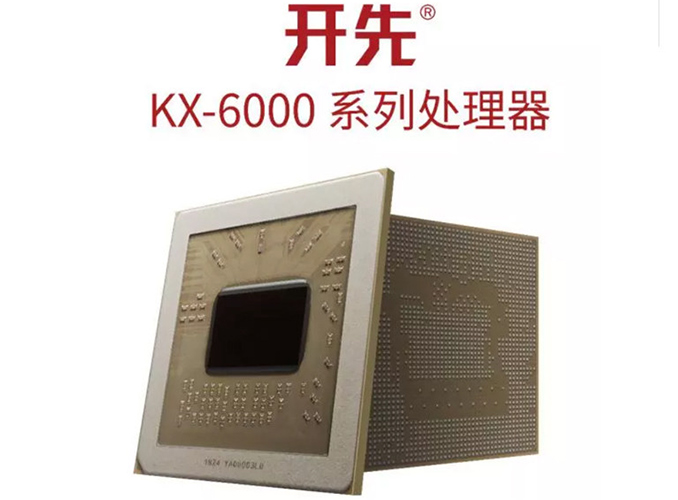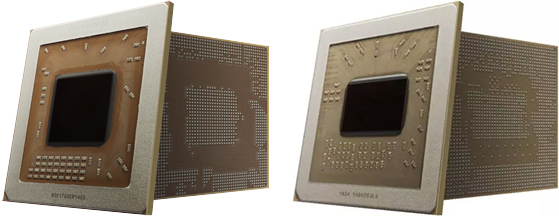Zhaoxin Displays x86-Compatible KaiXian KX-6000: 8 Cores, 3 GHz, 16 nm FinFET
by Anton Shilov on September 24, 2018 12:00 PM EST
Zhaoxin, a joint venture between Via Technologies and the Chinese government, this week for the first time displayed its upcoming x86-compatible CPU, the KaiXian KX-6000. The SoC features eight cores running at 3 GHz and increases performance over its predecessor by at least 50%.
The KaiXian KX-6000 is a successor to the KX-5000 CPU launched earlier this year. Both chips integrate eight-core x86-64 cores with 8 MB of L2 cache, a DirectX 11.1-capable iGPU with an up-to-date display controller, a dual-channel DDR4-3200 memory controller, contemporary I/O interfaces (PCIe, SATA, USB, etc), and so on. The key differences between the KaiXian KX-5000 and the KaiXian KX-6000 are frequencies and manufacturing technology: the former is produced using TSMC’s 28 nm fabrication process and runs at up to 2 GHz, whereas the latter is made using TSMC’s 16 nm technology and operates at up to 3 GHz. Zhaoxin claims that the Kaixian KX-6000 offers compute performance comparable to that of Intel’s 7th Generation Core i5 processor, which is a quad-core non-Hyper-Threaded CPU. Obviously, performance claims like that have to be verified, yet a 50% performance bump over the direct predecessor already seems beefy enough.
As the picture below shows, the thinner manufacturing process enabled Zhaoxin to make the KaiXian KX-6000 die smaller when compared to the predecessor, which will eventually shrink its manufacturing cost. Meanwhile, the two processors use different HFCBGA packaging and therefore cannot use the same motherboards. Meanwhile it is unknown whether the new KaiXian KX-6000 is compatible with Zhaoxin’s USB 3.1 Gen 2-capable ZX-200 chipset.
The Zhaoxin KaiXian KX-6000 relies on the LuJiaZui microarchitecture, which is an evolution of the WuDaoKou microarchitecture that powers the KX-5000 processor introduced in early 2018. Based on what we know today, the LuJiaZui is an x86-64-compatible superscalar, multi-issue, out-of-order microarchitecture that supports contemporary instruction sets extensions like SSE 4.2 and AVX along with virtualization and encryption technologies. Zhaoxin has yet to disclose differences between its LuJiaZui and WuDaoKou designs. Therefore, all we can do is speculate that since the microarchitectures are launched within one year from each other they are very similar, but the newer one has minor optimizations that, perhaps, enable higher clocks, improved caching, better memory support, etc.
Zhaoxin has not announced when it plans to start commercial shipments of its KaiXian KX-6000 processors, as right now it only displays its picture (which proves that it exists). Based on the previously published roadmap, we'd expect the CPU to hit the market in 2019, though when exactly is anyone's guess.
| Zhaoxin's Kaixian KX-5000 and KX-6000 CPUs | |||
| Kaixian KX-5000 WuDaoKou |
Kaixian KX-6000 LuJiaZui |
||
| Core Count | 4 - 8 | Up to 8 | |
| L2 Cache | 8 MB | 8 MB | |
| Frequency | Up to 2 GHz | Up to 3 GHz | |
| ISA | x86-64 | ||
| ISA Extensions | SSE 4.2, AVX | ? | |
| APIC | Yes | ||
| Virtualization | VMX technology, compatible with Intel's VT-X | ||
| Temperature monitoring, overheat protection | Yes | ||
| Power States | C1, C2, C3, C4, P-State | ? | |
| Hardware Encryption Engines | Advanced encryption engine (ACE), SHA-1, SHA-256, SM3/SM4, Randomizer | ? | |
| Security | TXT, EDB | ? | |
| iGPU | DirectX 11.1 feature set. Hardware-accelerated video encoding/decoding. Outputs: DP, eDP, HDMI, D-Sub Max Resolution: 4K Number of Displays: 3 |
? | |
| Packaging | x-ball HFCBGA 37.5 x 37.5 mm |
y-ball HFCBGA 37.5 x 37.5 mm |
|
| Process Technology | TSMC 28 nm | TSMC 16 nm FinFET | |
Related Reading:
- Cypress and Zhaoxin Have USB 3.1 Gen 2 USB Controllers
- China Calling: AMD Forms Joint Venture for x86 Server SoCs in China
- AMD Creates Quad Core Zen SoC with 24 Vega CUs for Chinese Consoles
Source: PC Watch











77 Comments
View All Comments
Fritzkier - Tuesday, September 25, 2018 - link
What do you expect from HStewart?PeachNCream - Tuesday, September 25, 2018 - link
Welcome to HStewart's distorted reality where EVERYTHING is somehow related to Intel. I'm sorry you blundered into his poorly worded shill drivel. The rest of us here usually ignore him.Topweasel - Tuesday, September 25, 2018 - link
Not like being nitpicky but Intel did not License AMD64 specifically. They have had a cross licensing deal for decades. Anything one does on X86 the other then has rights to.It's one reason Intel could not push AMD out the door when they sold the Fabs. They could puff their stomach. Push for more restrictions on AMD. But if the cross license agreement comes to an end they would be paying out the nose in royalties for AMD64 for like 5 years till they had a suitable replacement.
khanikun - Wednesday, September 26, 2018 - link
I don't know if anyone remembers that time period, but Microsoft came out and said they only want to support one version of x86-64. AMD was there first and their 64 bit procs were being gobbled up by consumers, so they chose that.Intel would end up losing marketshare if they created their own x86-64 procs that was supported by nothing or blow a lot of money hoping to get MS to change their mind. The logical solution was to start using AMD64. I very much like Intel (pretty much the only thing I buy) and I still laughed during the time, when they took AMD64, renamed it EMT64 and slapped it on their P4s. We all knew it was AMD64.
sa666666 - Tuesday, September 25, 2018 - link
It's useless to argue with HStewart, particularly when you're asserting that AMD could be in any way superior to Intel. In his world, Intel is the greatest thing since sliced bread, and has basically invented every noteworthy product in tech since the beginning of time. The fact that AMD could have invented something beforehand is an affront to his very existence.TheinsanegamerN - Monday, September 24, 2018 - link
You assume china paid for the x86 license. This is china. They would just steal it.KateH - Monday, September 24, 2018 - link
hmm, is temporary blindness a symptom of China Derangement Symptom? First sentence of the article as well as the post you're replying to spells it out- VIA Technologies (a Taiwanese company) owns an x86 license. They are receiving engineering resources from Chinese state-financed engineers. VIA are not selling the license, nor are they transferring it to "China".shelbystripes - Monday, September 24, 2018 - link
It’s a joint venture with the Chinese government. Joint ventures are two-way mutually beneficial partnerships; one party does not simply sign on to provide “engineering resources”. China is getting something out of this.If they’re really just contributing engineering resources, then what they likely get out of it is giving their engineers experience on x86 architectural design, so they can build their own (unlicensed) x86 chip later. That’s not dissimilar from “stealing”.
MrSpadge - Monday, September 24, 2018 - link
Sure they get something out of it - they can buy x86 chips from a source they trust more than US based chip makers. This helps with avoiding backdoors (at least foreign ones) and supply issues should the US be taken over by and unpredictable bully.Manch - Tuesday, September 25, 2018 - link
Now it's Trumps fault VIA is working with the Chinese and the Chinese don't spy on ANYBODY!! LOL Good Lord.Leave politics off the damn page please.